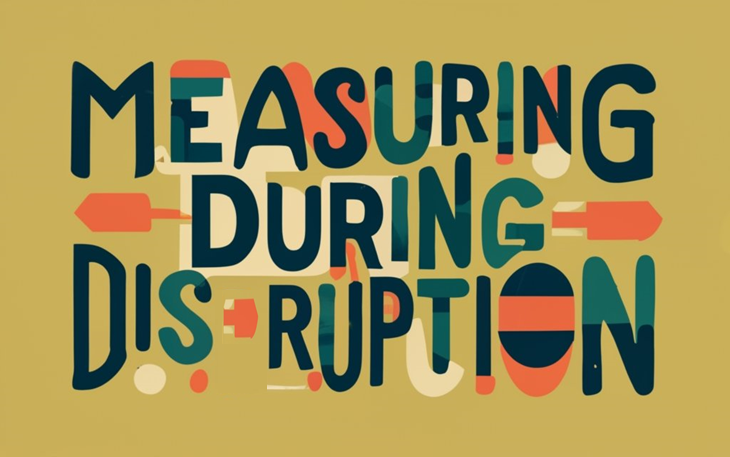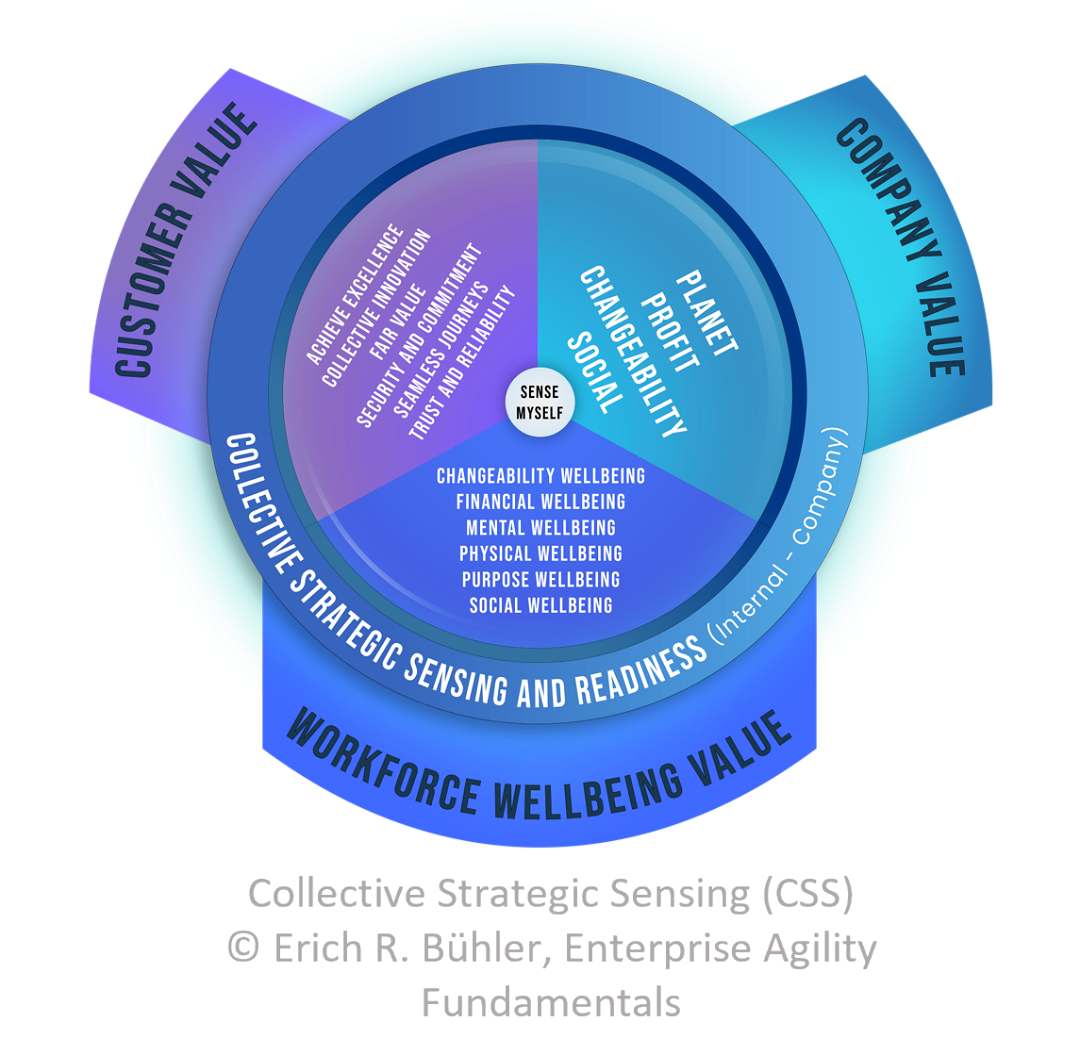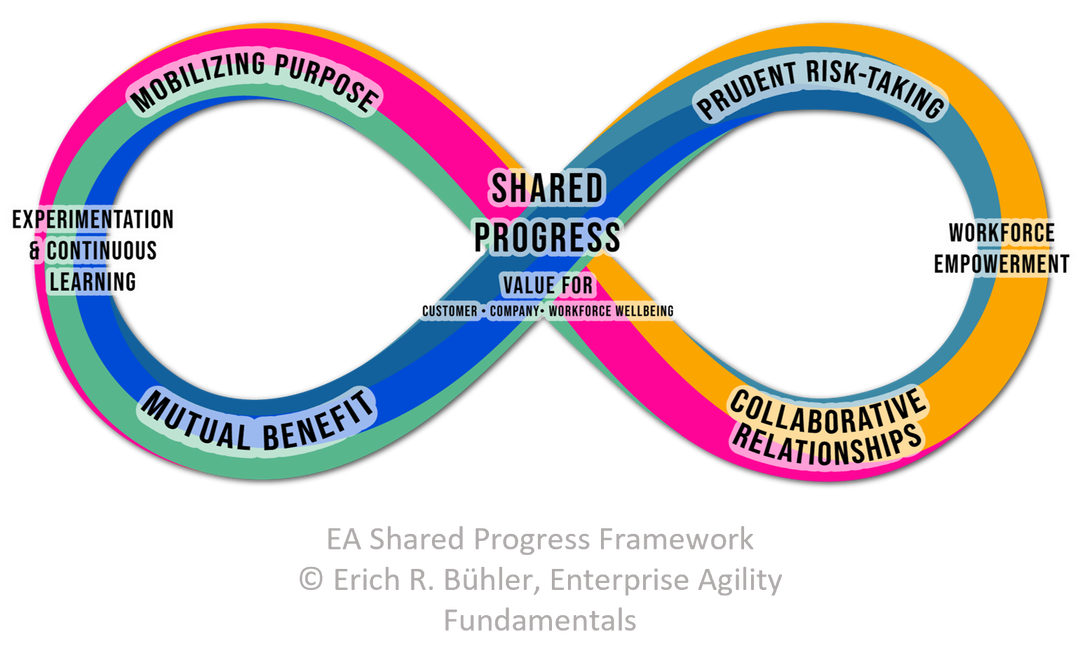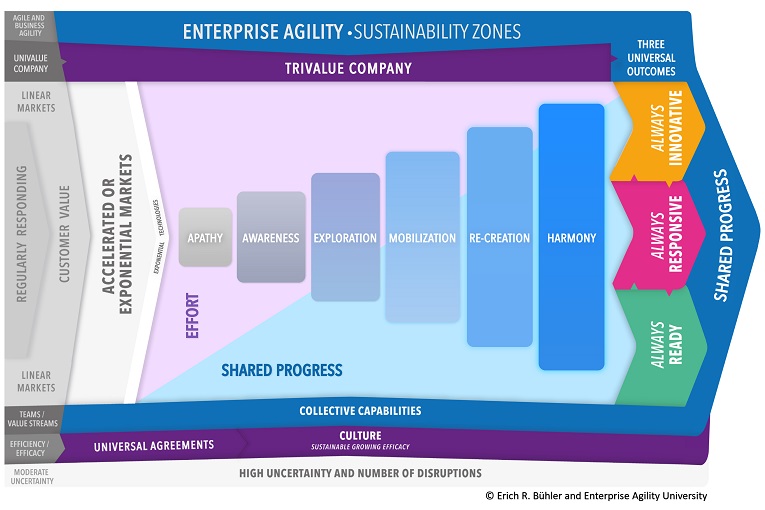Measuring the performance and progress of organizations can be challenging, especially during times of significant disruption and change.

There are many software products and services available to help organizations track metrics and key performance indicators based on Agile values and Principles. However, the turbulence and uncertainty of periods of change require a different approach to measurement than normal business.
When new technologies or business models reshape entire industries, traditional or business agility metrics may no longer be relevant. Companies need to develop a new framework to evaluate their strategy and business in real-time as the competitive landscape changes. Rather than committing to a fixed set of metrics, companies need more flexible and responsive measurement systems to gain insights into rapidly changing market conditions.
Enterprise agility provides a method and way of thinking to help organizations continuously and sustainably monitor their performance in turbulent times. The right metrics at the right time can provide the evidence-based progress and insights executives need to confidently lead their organizations into the future. But deciding what to measure and when requires a strategic approach that can empower people and sensing capabilities during complexity and exponential change.
As you will see, this differs from traditional approaches as Enterprise Agility builds an ecosystem during disruptive times that considers several dimensions.
Traditional metrics have focused mainly on lagging financial indicators or output metrics, which tend to focus only on the customer and often fail to capture the whole picture. In dynamic environments, leading indicators that assess capabilities, culture, responsiveness, readiness for change, and capabilities for innovation to increase provide crucial visibility. This is where Enterprise Agility's Spot Indicators and Three Universal Outcomes offer immense value.
Learn About Spot Indicators
Spot Indicators are Key Progress Indicators (KPI's) aligned to the three vital areas of value creation in the TriValue Company model—Customer Value, Company Value, and Workforce Wellbeing Value. By measuring high-level Spot Indicators in each area, such as Client Trust and Reliability or Workforce Resilience, you gain a balanced view of organizational health and capabilities. This prevents over-indexing on financials alone.

Spot Indicators also provide strategic foresight into risks and opportunities on a 0 to 12-month horizon. Since they focus on experiences and outcomes, Spot Indicators reveal where invisible threats or possibilities are emerging underneath the surface. This allows organizations to course correct proactively before small issues become crises.
The Three Universal Outcomes—Always Ready, Always Responsive, Always Innovative—complement Spot Indicators by defining the core capabilities organizations need to thrive in turbulent times. By regularly assessing through metrics if the company is progressing towards these outcomes, leaders can determine strategic gaps or strengths to guide priorities.
When used together, Spot Indicators and the Three Universal Outcomes form an evidence-based system for navigating complexity. But measurement only delivers value when executed with the right cadence and strategic perspective. Here are best practices for leaders when embracing Enterprise Agility or preparing the company to be disrupted:
- Adopt a bifocal approach and rhythm combining quarterly and monthly reviews. Quarterly assessments provide long-term strategic vision while monthly reviews deliver tactical foresight.
- Involve cross-functional teams or collective capabilities in determining and reviewing metrics to build buy-in and shared understanding.
- Focus on trends not numbers alone—look for patterns and changes in capabilities.
- Use Scales (1-5) to quickly highlight areas needing attention.
- Share compelling narratives around metrics to motivate and reveal future possibilities.
Consider Shared Progress
In addition to Spot Indicators and the Three Universal Outcomes, the Shared Progress framework is crucial for leaders seeking organizational sustainable flexibility through measurement. Shared Progress recognizes that sustaining value requires balancing the interests of customers, the organization, and the workforce. It moves past siloed metrics and priorities to take a systemic view.

When measuring and dealing with accelerated change change, Shared Progress ensures leaders consider the whole, not just isolated parts. It provides six guiding components for optimizing mutual benefit:
- Collaborative Relationships
- Experimentation & Continuous Learning
- Mobilizing Purpose
- Prudent Risk-Taking
- Workforce Empowerment
- Mutual Benefit
By assessing progress through these six lenses, leaders gain a multidimensional view of change capabilities and culture. They can identify where environments may constrain shared progress and create inclusive action plans.
Shared Progress complements Spot Indicators and the Three Universal Outcomes by emphasizing the importance of people, culture and mutual benefit. This prevents over-focusing on customers or finances (profits) alone.
As a framework, Shared Progress helps all areas in the company connect and share purpose and build shared metrics, too. Its six components guide leaders in creating empowering environments for navigating change together.
As you can see, Shared Progress provides the cultural foundation for Enterprise Agility. By incorporating its principles into measurement, teams, and collective capabilities, leaders can accelerate transformation and create lasting value for all stakeholders.
Know Your Sustainability Zone, Know Your Metrics
The Enterprise Agility Sustainability Zones provide a valuable framework for tying measurement strategy to a company's current context and capabilities.

The six zones - Apathy, Awareness, Exploration, Mobilization, Re-Creation, and Harmony—represent progressive levels of adaptability. Where an organization falls on this continuum offers critical insights for measurement. In early zones like Apathy and Awareness, metrics should focus on building foundational change capabilities and spurring new thinking. Assessments of innovation climate, learning culture and change readiness take priority.
In middle zones like Exploration and Mobilization, measurement should tie to piloting new practices and building organizational agility. Key indicators involve iteration velocity, partnerships and employee empowerment.
In advanced zones like Re-Creation and Harmony, metrics should connect to ingraining adaptability across the business. Measure the ease of reinventing business models, automated insights and collective creativity.
While the specifics will differ for each company, the Sustainability Zones provide a model for aligning measurement with maturity and priorities. By assessing your organization's current zone, you gain clarity on capabilities to measure now to progress to the next level.
Knowing your zone allows you to focus measurement on the areas that will provide the most strategic value and spur positive change during accelerated times. It prevents wasting efforts measuring advanced capabilities when foundational components are still lacking. With the Sustainability Zones, you have a roadmap for what to measure and when. By tying metrics to your specific zone, you build enterprise agility in the most effective sequence.
Think About Measurements, Mindset, and EA New Approaches
As you can see, with the right measures, mindset, and new approaches, you can cut through ambiguity and unite your organizational capabilities around a shared understanding of risks, opportunities, and strategic priorities.
Spot Indicators, the Three Universal Outcomes, and the Sustainability Zones provide a ready-to-use system for evidence-based progress. By putting these tools into practice, you can confidently navigate change.
